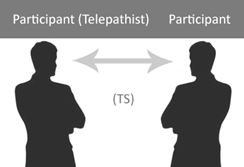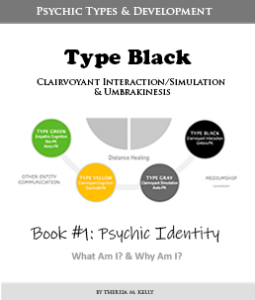- What Am I? (Type Purple)
- Psychic “Ability” (Type Purple)
- Psi, ESP, & Clairvoyance (Type Purple)
- Dreams, Impressions, & Hallucinations (Type Purple)
- Telepathic Simulation (Type Purple)
TELEPATHIC SIMULATION
The two main types of extrasensory perception talked about before, telepathy and clairvoyance, may seem somewhat similar too, but are actually quite different. Telepathy involves a connection and influence between two minds, while clairvoyance involves a connection and influence between the state of a physical object, person, or situation to a mind. This means that nature, or the universe, as a whole is always aware of the physical state of affairs, which in turn communicates such information to a mind. It helps if you think of the universe as one big computer or living brain that is aware, can think, and can form memories.
This difference between telepathy and clairvoyance is taken to be a difference between two forms of experiences. The goal of telepathic experiences is assumed to involve a person’s thoughts or mental states (example: how a person feels, thinks). In contrast, the goal of clairvoyant experiences is assumed to involve a physical situation or event that may or may not include other people.
This is viewed as telepathy being “direct,” since it involves a direct connection between two minds; whereas clairvoyance is viewed as “indirect,” because it only results in finding out about the physical situation of a thing or person, rather than directly finding out about a person through the person them self.
There are three sub-types of Telepathy:
- Telepathic Cognition (TC) applies whenever information is telepathically received by the experiencer from person.
- Telepathic Interaction (TI) applies whenever information is telepathically received by a person from the experiencer.
- Telepathic Simulation (TS) applies whenever information is telepathically shared between the experiencer and a person.
 The main feature of Telepathic Simulation is best described as a case of telepathy where a person’s mental state appears to produce an exact or similar mental state in someone else.
The main feature of Telepathic Simulation is best described as a case of telepathy where a person’s mental state appears to produce an exact or similar mental state in someone else.
In other words, the experiencer’s thoughts or emotions are shared with another person or people where the content of the shared mental state is the same or almost the same in both the experiencer and the other person or people. Also, this can work in reverse, where another person’s or people’s mental state appears to produce an exact or similar mental state in the experiencer.
The identicalness of the mental state not known for sure, as there is no scientific evidence to support this at this time. However, reports relating to this type of telepathy suggest exact, or nearly exact, mental states rather than more associative states. For example, when shared content is an image both the experiencer and other person may see a “star” but the shape of the star may be exact or different.
 Or, one may see a “star” and the other may see a similar shape such as a “pinwheel” or “flower.”
Or, one may see a “star” and the other may see a similar shape such as a “pinwheel” or “flower.”
Telepathic simulation also appears to be less intrusive or aggressive than other forms of telepathy because the experiencer and other people are usually unaware that, or do not know that the mental state is “not their own.” This is because the mental state appears to be less forceful and foreign, and therefore it feels more NATURAL. The skilled experiencer is however able to tell that the simulated mental state did not come from their own mind, but another’s mind by backtracking

Again, the experiencer can share his/her own mental state with another person, or the other person can share his/her own mental state with the experiencer.
Basically, both are capable of the sharing processes but only the experiencer can start the sharing process, when the information is shared it replaces the previous mental state of the “receiver.”
Another feature that appears to be unique to telepathic simulation is that of “networking.”
 In the case telepathic simulation networking the experiencer is not only able to interact with one person, which is uncommon with telepathic interaction experiencers and somewhat less uncommon with telepathic cognition experiencers, but rather they can “network” their ideas and emotions to small to larger groups of people at the same time.
In the case telepathic simulation networking the experiencer is not only able to interact with one person, which is uncommon with telepathic interaction experiencers and somewhat less uncommon with telepathic cognition experiencers, but rather they can “network” their ideas and emotions to small to larger groups of people at the same time.
 In other words, experiencers of telepathic simulation usually work with groups of people and their combined mental states and share with many people just as effectively as they do with a single person. In a sense, they work to get a group of people “on the same page.”
In other words, experiencers of telepathic simulation usually work with groups of people and their combined mental states and share with many people just as effectively as they do with a single person. In a sense, they work to get a group of people “on the same page.”








